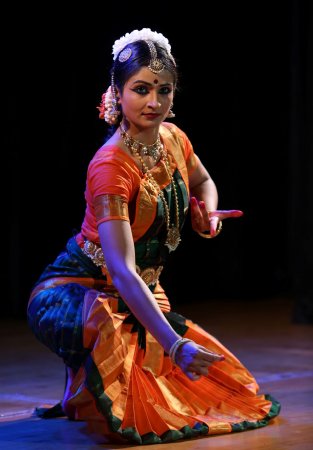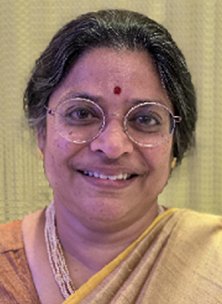
|   |

|   |
An exposition of line and form - Dr.Ganga Lakshmi Srinivas e-mail: gangalakshmi@gmail.com February 10, 2024 Dr. Shriya Srinivasan, senior dancer of Shri Kalaa Mandir of Cleveland, performed a traditional Margam, hosted by the well-established Dhvani of Columbus at the beautiful theater at the Peggy R. McConnell Arts Center of Worthington in Ohio. The performance was a harmonious, well-balanced Margam that began with a joyous Mallari in Gambhira Natai set to tisra triputa talam, composed in the 1990s by V.S. Muthuswamy Pillai. In addition to conveying the fun of a procession, Shriya gave us a taste of complex footwork in her exploration of the tisra triputa talam in 3 speeds. The melodious song Sharade karunanidhe in Hamir Kalyani continued the theme of celebration and pomp. Shriya's depiction of the brilliant glittering Sharadamba of Sringeri was a study in clean lines, powerful movements cloaked in grace, and that constant thread of charming abhinayam that distinguishes the Vazhuvoor tradition she inherits from her mother, Guru Sujatha Srinivasan.  In the varnam Roopamu joochi, Shriya fulfilled the promises she had made in the first two dances. She commanded the space in her complex nritta pieces. Her use of abhinayam during nritta ensured that those physically demanding segments did not descend into an exposition of calisthenics, which unfortunately happens all too often in Bharatanatyam performances. She was believably both a maiden in love and the powerful Thyagaraja of the cosmic dance. Guru Sujatha's choreography that explored stories of Shiva's other manifestations made for interesting nritya, but also needed a knowledge of the stories as well as of Bharatanatyam lexicon to comprehend. This leads to the question: when presenting to a mixed audience, how much complexity to incorporate? Does the dancer/ choreographer satisfy their desire to present their deepest understanding, or should they aim for the middle ground? I think Shriya's expertise made that conundrum a moot point, since even if the deeper nuances were not comprehensible to all, her performance itself was enough. A paragraph to devote to abhinayam - not in its meaning of conveying emotion, but the laid-down-in-the-Natya Sastra-rules of using forehead, eyebrows, lids, glances, the cheeks, the lips, the teeth. Whoever flutters their eyebrows, either in distress, or to charm? Yet it is a convention of this art form. The mettle of a Bharatanatyam artiste lies in deploying all these artifices such that the audience sees only the emotion these devices are intended to convey, not the artificiality per se of the component movements (especially the fluttering eyebrows). Shriya is such an artiste. The varnam is the acknowledged center piece of a margam, but to me Shriya shone in the javali. She sat for most of the javali, yet the stage did not feel empty. Indeed, the segments where she stood and moved felt like a distraction from the concentration of attention and emotion she evoked from the floor at center front. Prana sakuditu in Chenjurutti was a great piece to follow the varnam in terms of emotional themes - the maiden in love is now the matron betrayed. Heavy stuff, and very well done. And Jagadhodharane following the javali was a blessed relief, playful, full of movement evoking the mischievous child, though still imbued with the richest of emotions. Guru Sujatha and Shriya's partnership in the thillana (composed by Madurai T.N. Seshagopalan, Niroshta ragam, adi talam) delivered a visual treat. The choreography cleaved to the tradition of symmetrical patterns but used the stage to its fullest. The jathis played with the talam, with unexpected pauses and emphases enhanced by the clean precision of Shriya's footwork. At the end of a really demanding Margam, Shriya remained fluid, athletic, perfectly on time, and convincingly smiling. In the Q&A that followed, Shriya spoke of her integrating her study of biomechanics (she is an Assistant Professor at Harvard conducting research on artificial limb interface with neurons) into shaping her practice of dance - I can only hope this keeps her joints free for a very long time from the arthritis this demanding discipline bestows on its adherents. The very last piece harked to the social themes Sujatha Srinivasan and Shriya have choreographed in the past several years. Perumal Murugan's poem Naadu vittu naadu nadhi (melody by TM Krishna) questioned the justice of artificial borders set by politics and social norms. I am always sad when I watch a Bharatanatyam performance without musicians present. The bhava that musicians bring when live and the performers' appreciation of each other's efforts create an unparalleled immersive experience. Some aspects of the recordings were also a distraction in that volumes were different for each song, and some of the recorded songs ended in recorded applause. That said, I appreciate the logistic challenges of presenting traditional dance. If one were to only present when all elements are optimal, we would forgo regular doses of live performances, and fail to celebrate the transmission of diverse traditions despite isolation and struggle. I for one am very grateful for the opportunity to watch a performance of this caliber and complexity. The organizers of Dhvani India Performing Arts Society of Central Ohio are to be commended for their long history of showcasing the highest quality of Indian traditional arts.  Dr. Ganga Lakshmi Srinivas is a practicing pediatrician in Cleveland, Ohio. Her love for the Indian performing arts began in childhood growing up in a family that reveres music, and has continued to be nurtured in the rich landscape of tenacious teachers and performers who keep traditional arts thriving in the United States. |